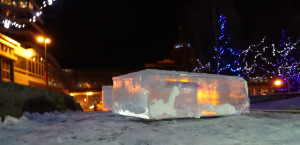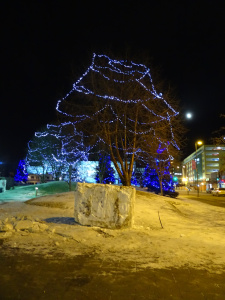
The lighting of a cross during the Christian Los Escobazos Festival in Spain, celebrating the conception of the Virgin Mary (Getty Images)
Atheism is on the rise around the world, so does that mean spirituality will soon be a thing of the past? Rachel Nuwer discovers that the answer is far from simple.
A growing number of people, millions worldwide, say they believe that life definitively ends at death – that there is no God, no afterlife and no divine plan. And it’s an outlook that could be gaining momentum – despite its lack of cheer. In some countries, openly acknowledged atheism has never been more popular.
“There’s absolutely more atheists around today than ever before, both in sheer numbers and as a percentage of humanity,” says Phil Zuckerman, a professor of sociology and secular studies at Pitzer College in Claremont, California, and author of Living the Secular Life. According to a Gallup International survey of more than 50,000 people in 57 countries, the number of individuals claiming to be religious fell from 77% to 68% between 2005 and 2011, while those who self-identified as atheist rose by 3% – bringing the world’s estimated proportion of adamant non-believers to 13%.
While atheists certainly are not the majority, could it be that these figures are a harbinger of things to come? Assuming global trends continue might religion someday disappear entirely?
It’s impossible to predict the future, but examining what we know about religion – including why it evolved in the first place, and why some people chose to believe in it and others abandon it – can hint at how our relationship with the divine might play out in decades or centuries to come.

A priest in Ukraine holds a cross in the ruins of Kiev’s Trade Union building earlier this year (Getty Images)
Scholars are still trying to tease out the complex factors that drive an individual or a nation toward atheism, but there are a few commonalities. Part of religion’s appeal is that it offers security in an uncertain world. So not surprisingly, nations that report the highest rates of atheism tend to be those that provide their citizens with relatively high economic, political and existential stability. “Security in society seems to diminish religious belief,” Zuckerman says. Capitalism, access to technology and education also seems to correlate with a corrosion of religiosity in some populations, he adds.
Crisis of faith
Japan, the UK, Canada, South Korea, the Netherlands, the Czech Republic, Estonia, Germany, France and Uruguay (where the majority of citizens have European roots) are all places where religion was important just a century or so ago, but that now report some of the lowest belief rates in the world. These countries feature strong educational and social security systems, low inequality and are all relatively wealthy. “Basically, people are less scared about what might befall them,” says Quentin Atkinson, a psychologist at the University of Auckland, New Zealand.

Yemeni girls show their hands decorated with traditional henna designs as they celebrate the end of Ramadan (Getty Images)
Yet decline in belief seems to be occurring across the board, including in places that are still strongly religious, such as Brazil, Jamaica and Ireland. “Very few societies are more religious today than they were 40 or 50 years ago,” Zuckerman says. “The only exception might be Iran, but that’s tricky because secular people might be hiding their beliefs.”
The US, too, is an outlier in that it is one of the wealthiest countries in the world, but also has high rates of religiosity. (Still, a recent Pew survey revealed that, between 2007 and 2012, the proportion of Americans who said they are atheist rose from 1.6% to 2.4%.)
Decline, however, does not mean disappearance, says Ara Norenzayan, a social psychologist at the University of British Columbia in Vancouver, Canada, and author of Big Gods. Existential security is more fallible than it seems. In a moment, everything can change: a drunk driver can kill a loved one; a tornado can destroy a town; a doctor can issue a terminal diagnosis. As climate change wreaks havoc on the world in coming years and natural resources potentially grow scarce, then suffering and hardship could fuel religiosity. “People want to escape suffering, but if they can’t get out of it, they want to find meaning,” Norenzayan says. “For some reason, religion seems to give meaning to suffering – much more so than any secular ideal or belief that we know of.”

In the Philippines, survivors of Super Typhoon Haiyan march during a religious procession (Getty Images)
This phenomenon constantly plays out in hospital rooms and disaster zones around the world. In 2011, for example, a massive earthquake struck Christchurch, New Zealand – a highly secular society. There was a sudden spike of religiosity in the people who experienced that event, but the rest of the country remained as secular as ever. While exceptions to this rule do exist – religion in Japan plummeted following World War II, for instance – for the most part, Zuckerman says, we adhere by the Christchurch model. “If experiencing something terrible caused all people to become atheists, then we’d all be atheists,” he says.
The mind of god
But even if the world’s troubles were miraculously solved and we all led peaceful lives in equity, religion would probably still be around. This is because a god-shaped hole seems to exist in our species’ neuropsychology, thanks to a quirk of our evolution.
Source: BBCNews Read more
 Now this piece, here is some real talent. I mean, the symmetry of it…
Now this piece, here is some real talent. I mean, the symmetry of it…

















